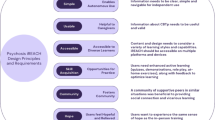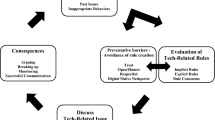Abstract
Rises in technology have created change in the family therapy field. The ethics code and regulatory boards now include areas on technology in family therapy practices. These additions require competency in the area of couple and family therapy technology practices. Previous researchers suggest there is a gap between these competencies needed and the training provided, as well as the research available. Thus, the purpose of this mixed-data survey study was to gain information regarding family therapists’ experiences and perceptions of education regarding online family therapy practices. To do this, we administered a survey to family therapists across the United States. Reported, are both quantitative, as well as qualitative findings. The majority of the sample reported that they did not learn about online technologies in clinical practice; however the majority of the participants would like to learn more about couple and family therapy technology practices. The most direct implication of the findings from our study is the need to offer specific education around couple and family therapy technology practices. Suggested core competency areas to cover include theory, research, and practice around technology.
Similar content being viewed by others
References
American Association for Marriage and Family Therapy. (2015). Revised American Association for Marriage and Family Therapy code of ethics. Retrieved from http://www.aamft.org/iMIS15/AAMFT/Content/Legal_Ethics/Code_of_Ethics.aspx.
Association of Marital and Family Therapy Regulatory Boards. (2015). 2015 AMFTRB national marital and family therapy examination: Handbook for candidates. Retrieved from http://www.amftrb.org/exam.cfm.
Baltimore, M. L. (2000). Ethical considerations in the use of technology for marriage and family counselors. The Family Journal: Counseling and Therapy for Couples and Families, 8(4), 390–393. doi:10.1177/1066480700084010.
Berger, P. L., & Kellner, H. (1970). Marriage and the construction of reality. In H. Dreitzel (Ed.), Recent Sociology (Vol. 2, pp. 50–72). New York: Macmillan.
Blumer, M. L. C. (in press). Couple and family therapy technology practices: A framework for ethical engagement. Family Therapy Magazine.
Blumer, M. L. C. (2014). Ecological elements in couple and family therapy technological practice. MFT Courier, 28(2), 2–5.
Blumer, M. L. C., & Hertlein, K. M. (in review). Tweet me, follow me, friend me: Prevalence of online professional networking between family therapists. Journal of Feminist Family Therapy: An International Forum.
Blumer, M. L. C., Hertlein, K. M., & Haider, A. (in revision). Exploration of marriage and family therapy online supervision: A mixed-data survey. The Clinical Supervisor.
Blumer, M. L. C., Hertlein, K. M., Smith, J. M., & Allen, H. (2014a). How many bytes does it take? A content analysis of cyber issues in couple and family therapy journals. Journal of Marital and Family Therapy, 40(1), 34–48. doi:10.1111/j.17520606.2012.00332.x.
Blumer, M. L. C., Hertlein, K. M., Walker, L., & Koble, J. (2014b). MFTs’ education of online practices & online professional networking. Presented at the American Association for Marital and Family Therapy Annual Conference, October 18, 2014, Milwaukee, WI.
Carlbring, P., Gunnarsdóttir, M., Hedensjō, L., Anderson, G., Ekselius, L., & Furmark, T. (2005). Treatment of social phobia: Randomised trial of internet-delivered cognitive-behavioural therapy with telephone support. The British Journal of Psychiatry, 190, 123–128. doi:10.1192/bjp.bp.105.020107.
Commission on Accreditation for Marriage and Family Therapy Education. (2005). Accreditation standards: Graduate & post-graduate marriage and family therapy training programs (version 11.0). Retrieved from https://www.aamft.org/iMIS15/AAMFT/Content/coamfte/coamfte.aspx.
Commission on Accreditation for Marriage and Family Therapy Education. (2014). Accreditation standards: Graduate & post-graduate marriage and family therapy training programs (version 12.0). Retrieved from https://www.aamft.org/iMIS15/AAMFT/Content/coamfte/coamfte.aspx.
Cuijpers, P. P., Donker, T. T., van Straten, A. A., Li, J. J., & Andersson, G. G. (2010). Is guided self-help as effective as face-to-face psychotherapy for depression and anxiety disorders? A systematic review and meta-analysis of comparative outcome studies. Psychological Medicine, 40(12), 1943–1957. doi:10.1017/S0033291710000772.
Gambrel, L. E., & Butler, J. L., V. I. (2013). Mixed methods research in marriage and family therapy: A content analysis. Journal of Marital and Family Therapy, 39, 163–181. doi:10.1111/j.1752-0606.201.00260.x.
Goldberg, P. D., Peterson, B. D., Rosen, K. H., & Sara, M. L. (2008). Cybersex: The impact of a contemporary problem on the practices of Marriage and Family Therapists (MFTs). Journal of Marital and Family Therapy, 34, 469–480. doi:10.1111/j.1752-0606.2008.00089.x.
Granic, I., Dishion, T. J., & Hollenstein, T. (2003). The family ecology of adolescence: A dynamic systems perspective on normative development. In G. R. Adams & M. D. Berzonsky (Eds.), Blackwell handbook of adolescence (pp. 60–91). Malden, MA: Blackwell.
Graves, T. (2005). Building a bridge between graduation and marriage and family therapy competency. Unpublished thesis, Utah State University, Logan.
Haddon, L. (2006). The contribution of domestication research to in-home computing and media consumption. The Information Society, 22, 195–203. doi:10.1080/01972240600791325.
Hadjistavropoulos, H. D., Thompson, M., Ivanov, M., Drost, C., Butz, C. J., Klein, B., & Austin, D. W. (2011). Considerations in the development of a therapist-assisted internet cognitive behavior therapy service. Professional Psychology: Research and Practice, 42(6), 463–471. doi:10.1037/a0026176.
Hailey, D., Roine, R., & Ohinmaa, A. (2008). The effectiveness of telemental health applications: A review. Canadian Journal of Psychiatry, 53(11), 769–778. Retrieved from http://psycnet.apa.org/psycinfo/2008-16547-008.
Hertlein, K. M. (2012). Digital dwelling: Technology in couple and family relationships. Family Relations, 61(3), 374–387. doi:10.1111/j.1741-3729.2012.00702.x.
Hertlein, K. M., & Blumer, M. L. C. (2013). The couple and family technology framework: Intimate relationships in a digital age. New York, NY: Routledge.
Hertlein, K. M., Blumer, M. L. C., & Mihaloliakos, J. H. (2014a). Marriage and family counselors’ perceived ethical issues related to online therapy. The Family Journal: Counseling and Therapy for Couples and Families. doi:10.1177/1066480714547184.
Hertlein, K. M., Blumer, M. L. C., & Smith, J. M. (2014b). Marriage and family therapists’ use and comfort with online communication with clients. Contemporary Family Therapy: An International Journal, 36(1), 58–69. doi:10.1007/s10591-013-9284-0.
Jencius, M., & Sager, D. E. (2001). The practice of marriage and family counseling in cyberspace. The Family Journal: Counseling and Therapy for Couples and Families, 9(3), 295–301. doi:10.1177/1066480701093009.
Johnson, H. (1971). The structural-functional theory of family and kinship. Journal of Comparative Studies, 2, 133–144. Retrieved from http://www.jstor.org/stable/41601168.
Livingstone, S., & Bober, M. (2005).Taking up online opportunities? Children’s uses of the Internet for education, communication and participation. Conference Papers—International Communication Association, 1–34. Retrieved from http://eprints.lse.ac.uk/418/.
Mackinnon, A., Griffiths, K. M., & Christensen, H. (2008). Comparative randomised trial of online cognitive–behavioural therapy and an information website for depression: 12-month outcomes. The British Journal of Psychiatry, 192(2), 130–134. doi:10.1192/bjp.bp.106.032078.
Mallen, M. J., Vogel, D. L., & Rochlen, A. B. (2005). The practical aspects of online counseling ethics, training, technology, and competency. The Counseling Psychologist, 33(6), 776–818. doi:10.1177/0011000005278625.
Merriam, S. B. (2002). Qualitative research in practice: Examples for discussion and analysis. New Jersey: Jossey-Bass Inc Pub.
Nelson, T. S., Chenail, R. J., Alexander, J. F., Crane, D. R., Johnson, S. M., & Schwallie, L. (2007). The development of core competencies for the practice of marriage and family therapy. Journal of Marital and Family Therapy, 33(4), 417–438. doi:10.1111/j.1752-0606.2007.00042.x.
Northey, W. (2002). Characteristics and clinical practices of marriage and family therapists: A national survey. Journal of Marital and Family Therapy, 28(4), 487–494. doi:10.1111/j.1752-0606.2002.tb00373.x.
Robinson, P. H., & Serfaty, M. A. (2001). The use of e-mail in the identification of bulimia nervosa and its treatment. European Eating Disorders Review, 9(3), 182–193. doi:10.1002/erv.411.
Spek, V., Cuijpers, P. I. M., Nyklícek, I., Riper, H., Keyzer, J., & Pop, V. (2007). Internet-based cognitive behaviour therapy for symptoms of depression and anxiety: A meta-analysis. Psychological Medicine, 37(03), 319–328. doi:10.1017/S0033291706008944.
Sussman, R. J. (1998). Counseling online [online]. Retrieved from http://www.counseling.org/ctonline/sr598/sussman.htm.
Wiersma, J. E., Titov, N., Van Schaik, D. J., Van Oppen, P., Beekman, A. T., Cuijpers, P., & Andrews, G. A. (2011). Treating chronic symptoms of depression in the virtual clinic: Findings on chronicity of depression in patients treated with internet-based computerized cognitive behaviour therapy for depression. Psychotherapy and Psychosomatics, 80(5), 313–315. doi:10.1159/000323167.
Williams, L., Johnson, E., & Patterson, J. E. (2013). The appropriate use and misuse of social media in MFT training programs: Problems and prevention. Contemporary Family Therapy: An International Journal, 35, 698–712. doi:10.1007/s10591-013-9256-4.
Winter, G., & Bamond, R. (2014). Ethical challenges of distance-based supervision. Presented at the American Association for Marital and Family Therapy Annual Conference, October 19, 2014, Milwaukee, WI.
Wootton, B. M., Titov, N., Dear, B. F., Spence, J., & Kemp, A. (2011). The acceptability of Internet-based treatment and characteristics of an adult sample with obsessive compulsive disorder: an Internet survey. PLoS ONE, 6(6), e20548. doi:10.1371/journal.pone.0020548.
Author information
Authors and Affiliations
Corresponding author
Rights and permissions
About this article
Cite this article
Blumer, M.L.C., Hertlein, K.M. & VandenBosch, M.L. Towards the Development of Educational Core Competencies for Couple and Family Therapy Technology Practices. Contemp Fam Ther 37, 113–121 (2015). https://doi.org/10.1007/s10591-015-9330-1
Published:
Issue Date:
DOI: https://doi.org/10.1007/s10591-015-9330-1




